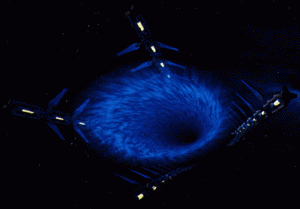 Have you ever noticed that humans seem to be waiting for aliens to visit us, rather than the other way around?
Have you ever noticed that humans seem to be waiting for aliens to visit us, rather than the other way around?
The reason for this is the commute. At its closest, Jupiter is roughly 390 million miles away. Alpha Centauri, the star system closest to Earth, is roughly 25 trillion miles away, or 4.3 light years. That’s a long time to play I Spy.
Science fiction solved this problem long ago. Star Trek ships warp. The Galactica spools up its FTL drive and jumps. The Millennium Falcon has hyper drive. Babylon 5 sends and receives interstellar traffic via jump gates.
Will humans ever master faster than light travel?
There are a few theories about how to do this, just as there are different types of faster-than-light travel in science fiction.
Hyper drive assumes the existence of hyperspace, an accessible alternate dimension. Hyper drive shoots a spaceship into this hyperspace, where it can travel at far greater speeds. The ship then re-enters real space when it reaches its destination.
Unlike hyper drive, jump drive instantaneously transports a ship to its destination, like teleportation. First suggested in Asimov’s Foundation series, a ship using jump drive could travel light years in an instant.
Hyper drive and jump drive rely on propulsion technologies. Scientists have made great strides in these technologies, particularly in ion propulsion, which uses solar panels to gather energy. A few years ago, the European Space Agency’s Smart-1 satellite successfully used ion propulsion. Still, it would take the Smart-1 approximately 81,000 years to reach Alpha Centauri.
Nuclear pulse propulsion, however, could get a spacecraft to Alpha Centauri in only 85 years. First proposed in 1947, NASA, DARPA, and other organizations have tried to develop this technology, but have run into technical and ethical complications, which makes sense given that the propulsion power is generated via nuclear explosion.
Warp drive avoids the issue of propulsion entirely. Instead, it manipulates the space-time that surrounds a ship, creating a kind of bubble, or a space-time bridge that a space craft enters. Warp drive is very similar to a wormhole, or a hypothetical shortcut through space. This is essentially the same idea as the tesseract proposed by Madeleine L’Engle in A Wrinkle in Time, in which people essentially fold space—if space is a sheet of paper and you’re on one side, you get to the other not by crossing the entire paper, but by folding the paper and stepping right to the other end.
Not all wormholes are traversable (a black hole won’t get you to Alpha Centauri), but many physicists believe that traversable wormholes spontaneously exist, although there isn’t any way to currently predict or create their appearance. All we need to do to create traversable wormholes ourselves is to get our hands on matter with negative mass and energy density. Someone ought to check Ebay.
Many physicists believe that right after the Big Bang, the universe expanded faster than the speed of light. One theory is that if we could get space to expand behind a ship and shrink in front of it, we could essentially create warp technology. The 11th dimension may hold the key to warp technology, as manipulating it could theoretically create dark energy, which is thought to cause the universe’s expansion.
One of the biggest advocates of the possibility of wormhole travel is Stephen Hawking, who believes that “the only way to get from one side of the galaxy to the other, in a reasonable time, would seem to be if we could warp space-time so much that we created a little tube or wormhole. This could connect the two sides of the galaxy and act as a short cut….” Of course, if we can warp space-time, then, theoretically, we should be able to time travel. But that’s another post for another time. For now, I’ll wait for the future me to come back and explain everything.

Proof of how quickly science moves: scientists believe they’ve found faster-than-light particles. Maybe we’ll be making that trip to Alpha Centauri faster than we thought…
http://www.guardian.co.uk/science/2011/sep/22/faster-than-light-particles-neutrinos?newsfeed=true